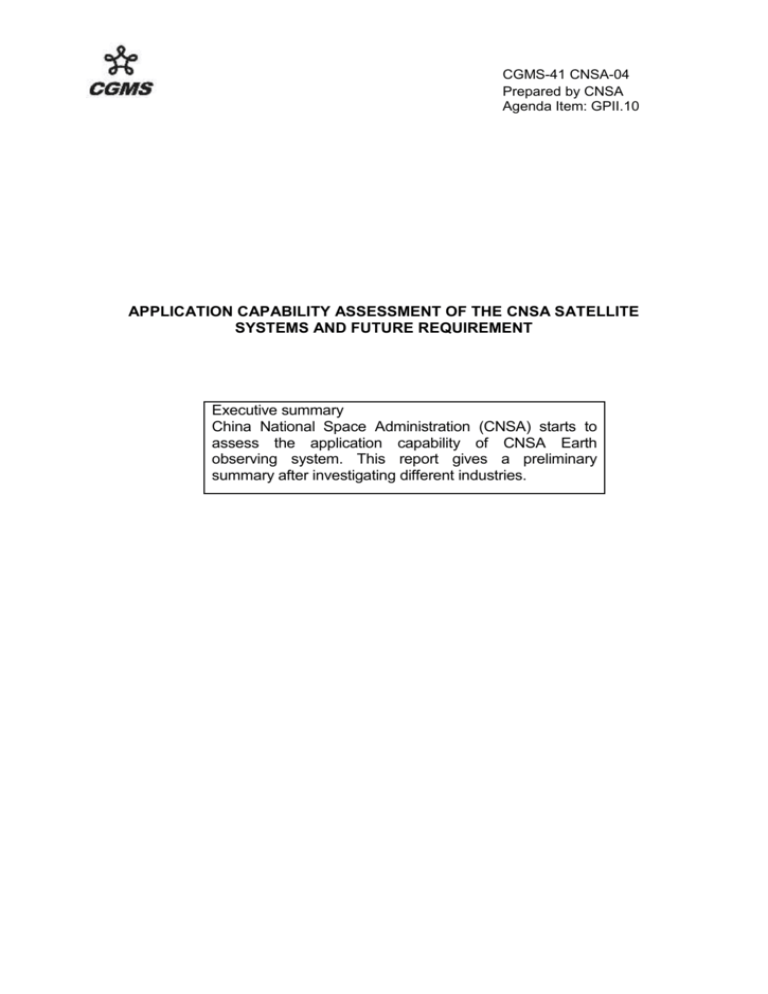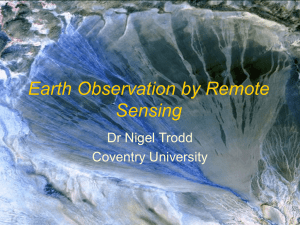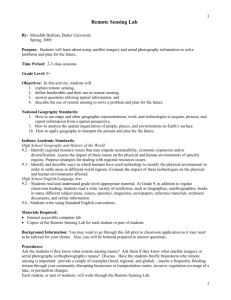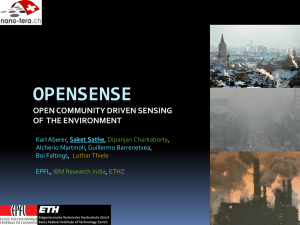application capability assessment of the cnsa satellite
advertisement

CGMS-41 CNSA-04 Prepared by CNSA Agenda Item: GPII.10 APPLICATION CAPABILITY ASSESSMENT OF THE CNSA SATELLITE SYSTEMS AND FUTURE REQUIREMENT Executive summary China National Space Administration (CNSA) starts to assess the application capability of CNSA Earth observing system. This report gives a preliminary summary after investigating different industries. CGMS-41 CNSA-04 Application capability assessment of the CNSA satellite systems and future requirement 1 INTRODUCTION OSCAR, a tool of Observing Systems Capability Analysis and Review, is an important part of the global integrated observing systems of WMO. China National Space Administration (CNSA) starts to use OSCAR software to assess the observing capability of its Earth observing system. AS the results of application-oriented, it is also necessary to assess the application capability of CNSA Earth observing system. This report gives the brief summary of our preliminary research at the start stage. 2 ASSESSMENT OF CURRENT APPLICATION CAPABILITY OF REMOTE SENSING By surveying and investigating with most administrations and ministries, the dependence of satellite remotes sensing technology for each industry becomes more and more important. Therefore, it is necessary for CNSA to assess and evaluate the application capability of remote sensing from different industry. With an overall consideration, CNSA could have a comprehensive EOS design and plan to better serve each industry. Currently, the remote sensing application in China is mainly used in land, natural disaster monitoring and evaluation, macroscale resource and environment investigation, land and resource protection, agriculture, and ecosystem environment. The detailed information are as follow: Application of remote sensing for urban is using remote sensing technology to process, extract, and analyze the information from urban dynamic change, heat island, water resource, solid waste, air environment, vegetation coverage and so on, then gradually forming the operational monitoring capability by remote sensing for urban landscape dynamic change, land dynamic use, waste, heat island. Application of remote sensing for surveying and mapping includes surveying and mapping, map revision, gravity measure, satellite height measure, and navigation and orientation. Application of remote sensing for meteorology includes weather forecast, Page 2 of 5 CGMS-41 CNSA-04 disastrous weather monitoring, such as flood, storm, typhoon, drought, high temperature, tornado, ice-snow disaster, heavy fog, lighting, etc. Application of remote sensing for ocean includes observations of ocean dynamics, ocean sea-level, shallow water, water depth, ocean colour, ocean pollution, sea-ice, etc. Application of remote sensing for water resource includes monitoring of flood and drought; management and diversion of water resource; ecosystem protection; management and construction of water conservancy project; planning and improving of conservation of water and soil; water environment monitoring. Application of remote sensing for disaster agriculture includes agriculture resource investigation and monitoring, biomass evaluation, agriculture disaster forecast, etc. Application of remote sensing for forestry includes disaster investigation and monitoring; ecosystem environment monitoring; investigation, evaluation, planning of forest, natural reserve, wetland; desertification monitoring; evaluation of ecosystem efficiency. Application of remote sensing for territorial resource includes basic geology investigation; land resource investigation and monitoring; geologic hazard monitoring and early warning, digital territory programme. Application of remote sensing for environment includes continuously dynamic monitoring of environment; air quality monitoring; forecast of pollution trend; water quality monitoring; solid waste monitoring; environment monitoring of large construction project. Application of remote sensing for disaster reduction includes monitoring of flood, drought, forest fire, snow disaster, earthquake, landslide, mud-rock flow, collapse; plant pests disease control of crop and forest; monitoring and assessment of natural disaster. Application of remote sensing for ecosystem includes monitoring of land use; land cover; ecosystem change of land, lake and rive, sea and ocean, urban; protection of biological diversity; monitoring and research of global change. 3 CATEGORY OF REQUIREMENT OF EARTH OBSERVING Although different industry has particular demands of remote sensing technology, it still can be summarized into three categories. Page 3 of 5 CGMS-41 CNSA-04 category Purpose Characteristics I Resource high quantification measurements, identification capability, investigation and spatial resolution. Dynamic monitoring Short repetition time, wide coverage, easy information II extraction III Fast response All-weather and all-day monitoring capability, Short repetition time, wide coverage, 4 REQUIREMENT OF SATELLITE REMOTE SENSOR After the conversion from application requirement to measurable parameters, it finally needs to be decided the type of sensor and its corresponding characteristics according to application task. With the analysis and filtration of all current satellite remote sensors, the feature requirement in the application task can be summarized as follow: observing mode, observing angle, spectral, temporal, spatial and radiometric features, shown in figure 1. requirement of sensor characteristics spectral spatial radiometric calibration observation others center wavelength GIFOV radiometric resolution before launch mode consistency FWHM HIS dynamic range after launch height linear SRF PSF SNR stability FOV stray light tolerance LSF RPM Figure 1. framework of characteristics requirement of application-oriented remote sensor 5 FUTURE REQUIREMENTS OF REMOTE SENSING FOR APPLICATION According to the urgent requirements of resource investigation, dynamic monitoring, and fast response, CNSA sorts out major Earth measurable parameters covering atmosphere, land, and ocean from 5 lays (retrievable parameters, measure precision, spatial resolution, dynamic observing range, and application response), and 3 phases (objective phase, R&D phase, and operational phase). There are totally about 800 measurable parameters. Base on these 800 measurable Page 4 of 5 CGMS-41 CNSA-04 parameters, CNSA is easily to estimate the future requirement of remote sensing for application and hence to better organize its future plan of sensor design and launch. Page 5 of 5








